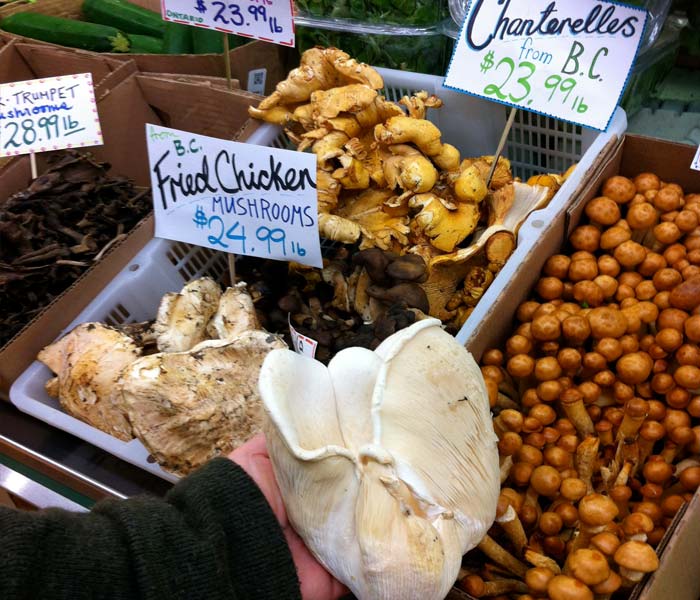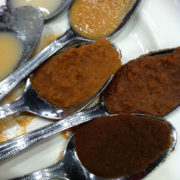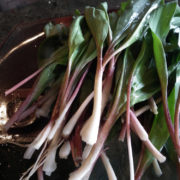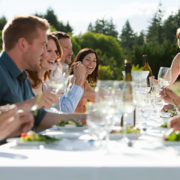Cooking Mushrooms and Locally Sourcing this Amazing Superfood

Sweet wood, fresh grass, sea spray, fresh bread, new apricots, spicy cinnamon, spring fungus, pine tree sap…These are not comments at a wine tasting but descriptions of the fragrances and flavours of freshly foraged matsutake (also called pine) mushrooms enjoyed at a Tree House Kitchen tasting. It featured the best mushrooms I have ever had!
Your palate will not miss a thing while taste-testing the layered flavours, fragrances and textures of fresh, farmed or foraged fruits and vegetables from your local market.
We thank Lisa, Theresa and Sharon of Picone Fine Food in Dundas for their excellent procurement of the season’s best mushrooms from across Canada. In the picture above, Lisa Picone holds a fantastic Ontario abalone mushroom. The tasting also featured “Nebrodi” mushrooms grown on a farm in Ancaster (check out this Spectator article: “Endangered Sicilian mushroom gets new life on Ancaster farm”). They were fabulous sliced thickly and added to a Chinese hot pot broth I brewed with our chopped vegetables at a knife skills class.
Even though the matsutake I tasted was foraged in BC and sourced for Dundas, the mushroom was so ALIVE and intoxicating in its freshness, richness and texture. Matsutake grows in the east, too.
The mushroom foraging season in the east is Octoberish, and in the west it’s Decemberish.
Let’s delve into some foraging secrets from BC’s Robin Steffanick, who kindly donated fresh chanterelles to my family for a special meal while I visited BC
Note: It is a must to trust an expert (and many reference books and much experience) when learning the details of foraging for edible mushrooms. A mistake can cost your life.
It is fun to hear foraging stories. Mr. Steffanick said that for wild mushrooms (in BC), “it was an exceptional year due to early September rains. Stories of weekend novices picking 70 pounds of chanterelles in one go were common this fall.” He wrote that he has “great success in fairly common areas just by knowing when (immediately after a heavy rain), where and how to LOOK.” He looks for complementary vegetation for clues. For example, he gets above and beyond the ferns and into the salal shrubs in old-growth forests. I found this fascinating, as I felt I could taste all of that in my favourite Pacific Northwest mushrooms—yum! Mr. Steffanick wrote, “Many people look, but cannot SEE!!! Same for finding golf balls or mushrooms.” Those lucky British Columbians, golfing and foraging into December!
By January, in Ontario, there are many exciting mushrooms in the stores to try—dried and fresh, but not necessarily foraged. Mushrooms are a superfood. In Japanese culture, matsutake mushrooms symbolize fertility, good fortune and happiness—and happiness is the long list of health benefits that mushrooms provide! Today, science is familiar with only a small percentage of the world’s full range of mushroom-forming fungi and their body-boosting natural health benefits. However, they are being studied all the time.
Just know that you cannot go wrong by trying out different mushrooms from your local stores and including them in your diet regularly, several ounces at a time. Besides being an excellent low-calorie food, mushrooms’ health benefits—at least the currently studied/known benefits—include maintaining blood sugar levels, strengthening metabolism, providing natural doses of vitamin D (if exposed to the sun, mushrooms manufacture their own!) and having anti-cancer and anti-tumour properties. Mr. Steffanick was foraging for matsutake to aid a friend with cancer.
Mushrooms provide antioxidants and have been described as “master antioxidants.” They improve immune system function and can be anti-bacterial, anti-viral, anti-fungal and anti-inflammatory. They have been known to improve diabetes, asthma and allergies as well. This is just a partial list!
In the bone-chilling Ontario cold, I grow some vitamin D within some mushrooms on my windowsill!
Quick Mushroom Cooking Tips
- Always, when you are readying your mushrooms to cook, save the woody-textured stems for a stock! Break the toughest segment from the mushroom body and wipe the dirt away with a damp paper towel or cloth. Freeze these woody stems in labelled freezer bags.
- Pull some frozen stems out when you have time and brew a delicious mushroom stock to add to other dishes and sauces (you can put this stock in the freezer, too).
- As a general rule when cooking mushrooms, go mild and relatively simple with accompanying ingredients to highlight the complexities of mushroom flavours. But given their health benefits, amazing supple texture and ability to take on the flavours of other ingredients, there is no right or wrong.
- Mushrooms, mild fish and other simply flavoured proteins are a great mix. But then again, they do well with robust red meats, too!
- Try sautéing varieties of mushrooms as a side dish or sandwich topping in a bit of olive oil or butter with a squeeze of fresh lemon and a sprinkle of salt. I love lots of sautéed or sweated mushrooms tossed with cooked al dente green beans, organic lemon zest, whole pine nuts, sweated garlic and sea salt. They are also fantastic as meaty julienne pieces in rustic soups and stews.
- I always include whatever mushroom I can find in Chinese Hot Pot soup.
- In our past Winter Evening in French Style cooking class, we offered this recipe: any mushroom braised with Cumbrae’s farm-raised pheasant (or chicken), handfuls of fresh rosemary, sliced lemon, capers and garlic with chicken or mushroom stock. The sautéed matsutake was fabulous with steak drippings (after we had seared some steaks), sweated chopped leeks and wild mushroom stock tossed with lightly cooked whole wheat rice noodles. We served this dish with the red wine (pinot noir variety) Beaune Clos Du Roi Premier Cru. The wine’s sour cherry, vegetative, fungal-like qualities were a great match!
- Try the above ideas; play around with ingredient amounts by using your instincts and taste buds. Explore, grow, nourish and connect!






Great mushroom article and picture. If you can’t hunt your own then Nancy’s class with Picone mushrooms is the next best thing.